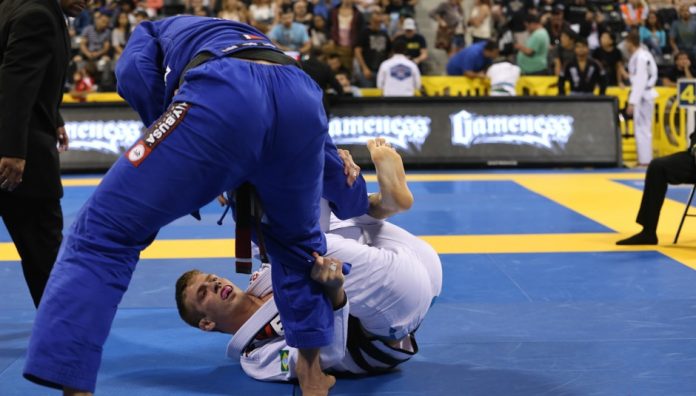
Lapel guards do present a major problem in modern BJJ. The Gi is a powerful weapon to use against any opponent. There is a multitude of chokes and different positions available through Gi manipulation. A unique trait of BJJ is using the opponent’s Gi against them by trapping them with various lapel guards. The lasso guard reigned supreme amongst open guards at the highest level of competition. However, as of late, another guard has taken over the mantle of most annoying guard to pass. Queue the notorious and very annoying, worm guard.
If you’re interested in Buying Keenan Cornelius’ Lapel Guard Encyclopedia you can check it HERE.
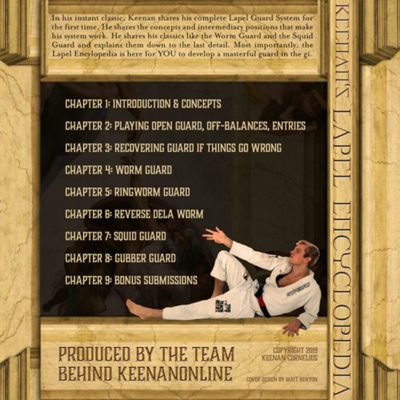
Ask any BJJ practitioner and they’ll tell you how much they despise the worm guard. It is a variation of the seated half guard, made more secure with the use of the lapel. The worm guard first surfaced in 2014, courtesy of BJJ European and World Champion Keenan Cornelius. Keenan has utilized the worm guard in many of his high-level black belt matches successfully. So much so, in fact, that other notable BJJ World Champions like Joao Miyao and Rafael Mendes soon followed suit. Of course, the entire Jiu-Jitsu community is never far behind when something as attractive and efficient as this guard comes along
Why Is The Worm Guard So Effective?
So, what is it that makes the worm guard so effective (read annoying)? In essence, the worm guard is a way of restricting your opponent’s movement by re-enforcing your open guard with their own lapel. This open guard position was developed by Atos Team’s Keenan Cornelius. Well, former Atos team member, anyway.
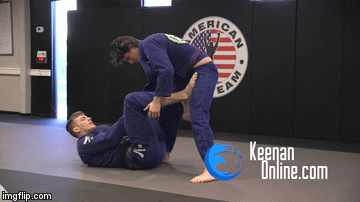
Simply lying to your side with everything in place as described is going to make your opponent lean forward. That’s an effortless posture break if ever there was one. What can the opponent do? The leverage created by this control severely restricts the movement of the passer, as well as their ability to put pressure on the bottom grappler. This way, a variety of sweeps, reversals, and back takes open up for the bottom player. Let’s say they try to knee slice. The inside leg prevents it. Backstep? There’s no way out of the loop created by the lapel grip. Pressure passing? They’ll go flying!
How Did World Champions Deal With the Worm Guard?
So, after the first version of the worm guard emerged, and Keenan got the best of most, what was the response? As expected, it didn’t take long for the top-level grapplers to start devising solutions. It is not that the guard is any less effective, it is just more of a fair fight now that we know a thing or two about it. Or so we thought, anyway. Just like with everything in BJJ, the worm guard also evolved and got better. Or more annoying. Whichever way you prefer it.
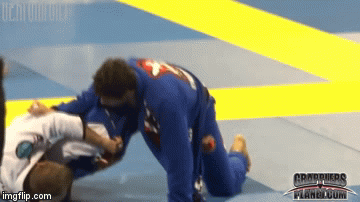
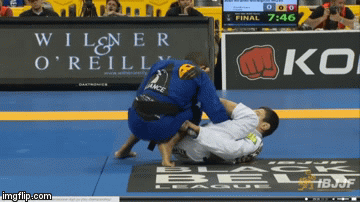
Passing The Worm Guard
Ultimately, people actually went a step further and found out how to pass the worm guard, rather than just counter its attacks. And it has everything to do with posture. Having good posture, regardless of which guard you are passing, is essential in BJJ. The minute your posture is broken, it will be easier for your opponent to attack. This is especially true in the case of lapel guards.
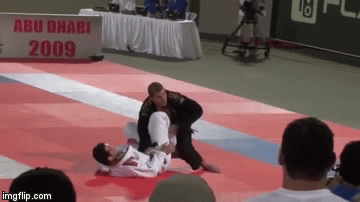
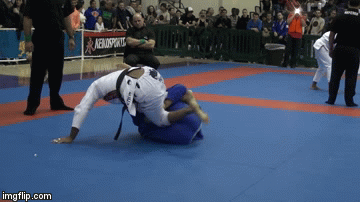
Which brings us to the latest evolution. Did Keenan choose to work on the worm guard in particular? Yes, he did, but he didn’t leave it at that. He created four more “cousin” lapel guards that now tie together into the most comprehensive lapel guard system ever put together!
Keenan’s Response And The Evolution Of The Lapel Guards Encyclopedia
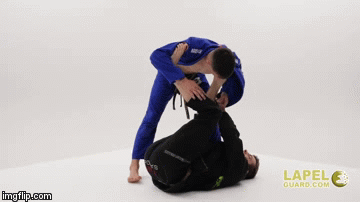
Three more lapel guard variations now provide options most of us have never dreamed of having when it comes to playing guard. The Reverse De La Worm (a Reverse De La Riva guard hybrid), the Squid Guard and the Gubber guard are the latest and greatest of Keenan’s inventions. Unlike the initial worm guard, all of these guards actually work together, feeding off each other. This means that now, whatever someone does form the worm guard, there’s a solution. And the solutions come in the form of far worse lapel guards that now actually feature even direct submission options.
If you’re really interested in learning them all, an entire series of articles won’t even scratch the surface. Your best resource is actually picking up the 10-part “Lapel Encyclopedia” instructional, available in both DVD and digital format. Keenan’s Lapel Encyclopedia features everything, from opening lapel guard concepts to worm guard strategies and recovery. Of course, each of the five guards gets a volume of itself, along with an entire volume filled with submission options. In fact, check out the most detailed review of Keenan’s Lapel Encyclopedia featuring the worm guard right HERE!
In Summary
The Worm guard evolution is just as captivating as that of any move in modern Jiu-Jitsu. Do you need to know it? Absolutely, particularly if you do Gi Jiu-Jitsu even on occasion. However, if you’re really interested in using it as your main tool in competition, particularly at a high-level, you need the entire Lapel Encyclopedia system. It is more than worth investing in.
If you’re interested in Buying Keenan Cornelius’ Lapel Guard Encyclopedia you can check it HERE.



![Darce Choke Encyclopedia – Origins, Mechanics and Variations [2024] BJJ, choke, Brabo, BJJ Darce Choke, D'arce Choke, Darce BJJ Choke](https://bjj-world.com/wp-content/uploads/2017/11/JungPoirierLeeYahoo-218x150.jpg)










![Best Marcelo Garcia Techniques by Team Marcelo Garcia DVD Review [2025] Best Marcelo Garcia Techniques by Team Marcelo Garcia DVD Review](https://bjj-world.com/wp-content/uploads/2025/02/best-marcelo-garcia-techniques-dvd-review-218x150.png)
![Forging The De La Riva Guard Giancarlo Bodoni DVD Review [2025]](https://bjj-world.com/wp-content/uploads/2025/02/de-la-riva-guard-giancarlo-bodoni-dvd-review-218x150.png)

![Breaking Their Guard Mikey Musumeci DVD Review [2025] Breaking Their Guard Mikey Musumeci DVD Review](https://bjj-world.com/wp-content/uploads/2025/02/breaking-their-guard-mikey-musumeci-dvd-review-218x150.png)


![Efficiently Executing X-Guard Giancarlo Bodoni DVD Review [2024] Efficiently Executing X-Guard Giancarlo Bodoni DVD Review](https://bjj-world.com/wp-content/uploads/2024/09/efficiently-executing-x-guard-giancarlo-bodoni-dvd-REVIEW-100x70.png)

![Front Headlock and Turtle Escapes Brian Glick DVD Review [2024] Front Headlock and Turtle Escapes Brian Glick DVD Review](https://bjj-world.com/wp-content/uploads/2024/11/headlock-and-turtle-escapes-brian-glick-dvd-review-100x70.png)
![Woj Lock the World Chris Wojcik Ankle Locks DVD Review [2024] Woj Lock the World Chris Wojcik Ankle Locks DVD Review](https://bjj-world.com/wp-content/uploads/2024/12/woj-lock-the-world-chris-wojcik-dvd-review-100x70.png)
![Essential Shin To Shin System Shawn Williams DVD Review [2025] Essential Shin To Shin System Shawn Williams DVD Review](https://bjj-world.com/wp-content/uploads/2025/01/shin-to-shin-system-shawn-williams-dvd-review-100x70.png)

![Just Pass Jay Rodriguez DVD Review [2024] Just Pass Jay Rodriguez DVD Review](https://bjj-world.com/wp-content/uploads/2024/11/just-pass-jay-rodriguez-dvd-review-100x70.png)

![Two Sides One Game Sweep and Pass Marcos Tinoco DVD Review [2024] Two Sides One Game Sweep and Pass Marcos Tinoco DVD Review](https://bjj-world.com/wp-content/uploads/2024/11/sweep-and-pass-marcos-tinoco-dvd-review-100x70.png)
![The Stack Pass Andre Galvao DVD Review [2025] The Stack Pass Andre Galvao DVD Review](https://bjj-world.com/wp-content/uploads/2025/01/the-stack-pass-andre-galvao-dvd-review-100x70.png)

![How to Double Leg Anyone Kevin Lee DVD Review [2024] How to Double Leg Anyone Kevin Lee DVD Review](https://bjj-world.com/wp-content/uploads/2024/11/how-to-double-leg-anyone-kevin-lee-dvd-review-100x70.png)

![Collar Sleeve Guard Mikey Musumeci DVD Review [2024] Collar Sleeve Guard Mikey Musumeci DVD Review](https://bjj-world.com/wp-content/uploads/2024/12/collar-sleeve-guard-mikey-musumeci-dvd-review-100x70.png)

![Dima Murovanni Kill The Collar Tie BJJ Trendsetters DVD Review [2024] Dima Murovanni Kill The Collar Tie BJJ Trendsetters DVD Review](https://bjj-world.com/wp-content/uploads/2024/09/dima-murovanni-kill-the-collar-tie-dvd-review-100x70.png)
![Tricks for Unstoppable Takedowns Georges St Pierre DVD Review [2024] Tricks for Unstoppable Takedowns Georges St Pierre DVD Review](https://bjj-world.com/wp-content/uploads/2024/12/unstoppable-takedowns-georges-st-pierre-dvd-review-100x70.png)
![Feet Finder Foot Sweeps Christian Ozbek DVD Review [2024] Feet Finder Foot Sweeps Christian Ozbek DVD Review](https://bjj-world.com/wp-content/uploads/2024/09/feet-finder-foot-sweeps-christian-ozbek-dvd-review-100x70.png)
![Leg Lock Strategies: Navigating Entanglements Jack Stapleton DVD Review [2024] Leg Lock Strategies: Navigating Entanglements Jack Stapleton DVD Review](https://bjj-world.com/wp-content/uploads/2024/12/navigating-entanglements-jack-stapleton-dvd-review-100x70.png)

![Darces From Everywhere Kade and Tye Ruotolo DVD Review [2024] Darces From Everywhere Kade and Tye Ruotolo DVD Review](https://bjj-world.com/wp-content/uploads/2024/10/darces-from-everywhere-kade-and-tye-ruotolo-dvd-cover-100x70.png)

![Breaking Their Guard Mikey Musumeci DVD Review [2025] Breaking Their Guard Mikey Musumeci DVD Review](https://bjj-world.com/wp-content/uploads/2025/02/breaking-their-guard-mikey-musumeci-dvd-review-100x70.png)



![Darragh O’Conaill Crucifix Encyclopedia DVD Review [2024] Darragh O'Conaill Crucifix Encyclopedia DVD Review](https://bjj-world.com/wp-content/uploads/2024/10/darragh-oconaill-crucifix-encyclopedia-dvd-review-100x70.png)